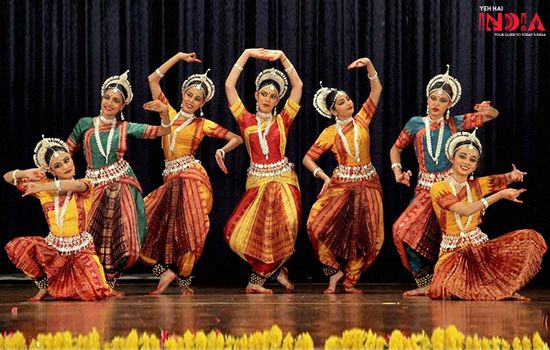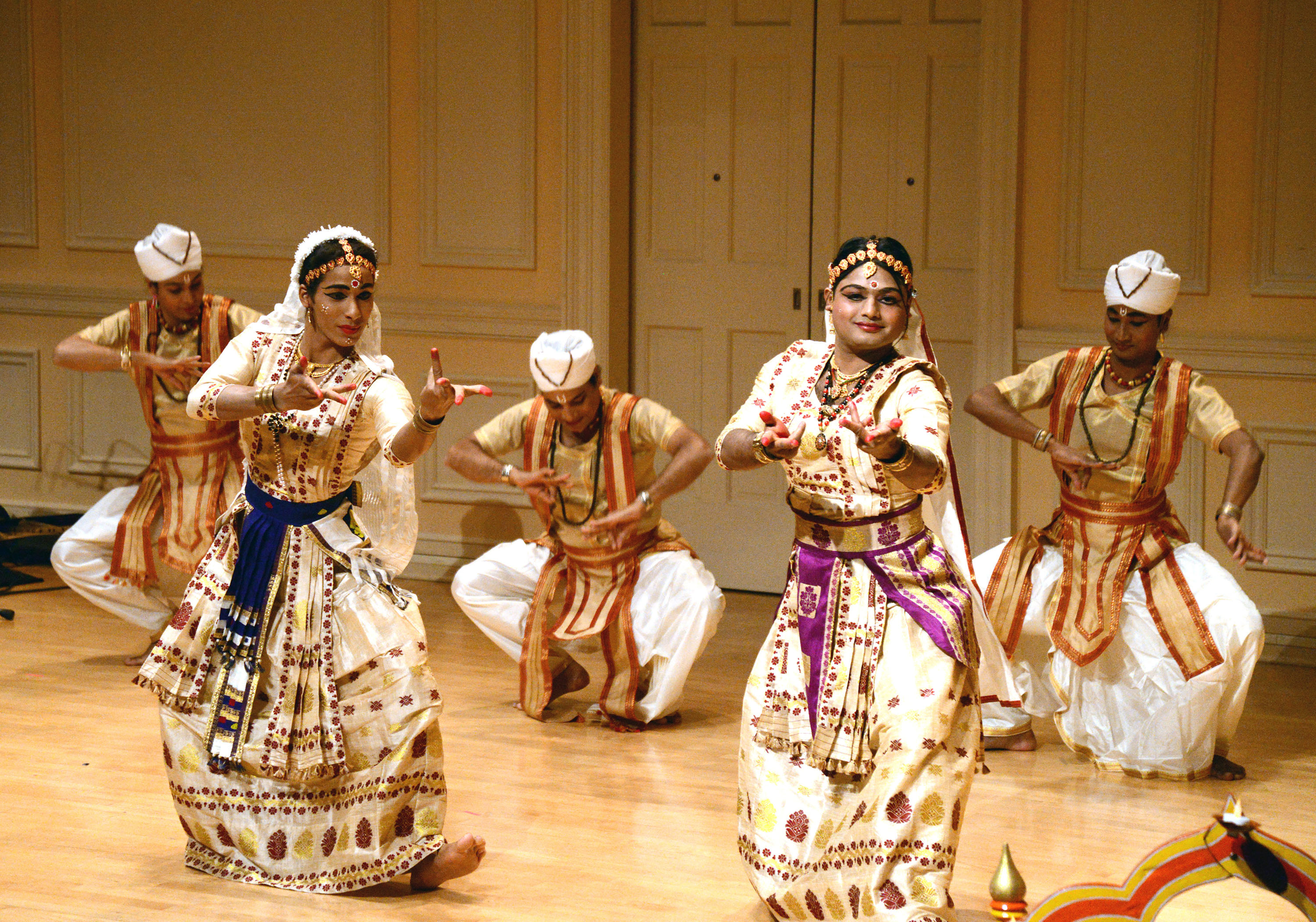India is a land which is rich in cultural diversity. Its people live a life filled with dance, music, delicacies and festivities. The country’s diversity is reflected in its varied cuisine, music and most importantly in the beautiful dance forms.
Classical dance forms of India, also known as Shastriya Nritya, come from the words, Shastriya meaning classical and Nritya meaning the act of dancing.

There are 8 classical dance forms in India. Let’s take a detailed look at each of these dance forms. Their names, history and origin are discussed in detail below.
Bharatanatyam

Originating from Tamil Nadu, Bharatanatyam dance style is an ancient and oldest classical dance form in India. Earlier its name was Sadhir Attam. Bharatanatyam is a temple dance and it tells stories from various Hindu scriptures.
History
The beginning of Bharatanatyam
The foundations of Bharatanatyam are present in Natya Shastra, the ancient Sanskrit Hindu text about performing arts. Archaeologists estimate the first compilation of the text to be between 200 BCE and 200 CE.
Another historical reference of Bharatanatyam style is found in spics like Manimegali as well as Silappatikaram. written in the 6th and 2nd centuries, respectively.
Furthermore, the carvings in Kanchipuram’s Shiva temple, suggest Bharatanatyam dance and style was developed as performance art by the first Millenium.
Modern authors as well as some colonial Indologists believe Bharatanatyam to be a descendant of ancient Devadasi culture, thus, suggesting its origin between 300 BCE and 300 CE. This belief is further strengthened by the depiction of the dance being performed by women in temple quarters in several historical scriptures. Throughout the 19th century, Bharatanatyam remained exclusive to Hindu temples. However, in the 20th century, it began appearing on stage outside temples.
Bharatanatyam during the colonial era
With the arrival of British rule in the 19th century, many Indian dance forms, including Bharatanatyam were mocked and discouraged. Thus, these art forms declined. Furthermore, Christian missionaries presented the devadasis of south India as evidence of harlots and an erotic culture that must be stopped. In 1910, the Madras Presidency outlawed temple dancing, and with it, Bharatanatyam.
Bharatanatyam in the modern world
After India gained independence, Bharatanatyam rapidly expanded throughout all communities. Many people then began practising the dance which led to a number of schools offering lessons in Bharatanatyam. Now, there are four styles of Bharatnatyam, namely, Melathoor, Pandanalloor, Vazhavoor, as well as Kalashetra.
Other Bharatanatyam lessons at learning Bharatanatyam online
Kathak

The dance form Kathak originated from the state of Uttar Pradesh. It is a mix of worshipping deities and story narration. Grace, hand gestures and body pose as well as eye movements combine to make Kathak a graceful sight.
A Kathak performance starts with a dancer offering respect to the guru and prayer to receive god’s blessing. Then the dancer moves on to the dance. The music that accompanies a Kathak performance uses different classical instruments like Sarangi Seeta, Manjira, Tabla, Harmonium, etc.
History
Kathak in ancient India
The roots of this dance form trace back to Natya Shastra, an ancient Hindu text written by musicologist Bharata Muni. The word Kathak comes from the Vedic Sanskrit word ‘Katha’ meaning ‘story’. Thus, Kathak refers to a person who tells stories through dance.
With the arrival of Mughals in India, dancers began performing the ancient classical dance in Mughal courts. Although improvisations were made to amuse the Muslim audience, the performances still contained a subtle message like the love of Radha-Krishna. Soon, Central Asian, as well as Persian themes, became a part of the performances. Some of the changes include replacing a sari with a costume that bared midriff and the addition of a transparent veil. By the time the British arrived in India, Kathak had already gained popularity as court entertainment.
The decline of Kathak during British rule
The colonial rule saw the decline of various dance forms. Kathak was one of them. Additionally, the social stigma associated with Kathak and court entertainment, led to the launch of the anti-dance movement in 1982, thus, banning Kathak.
Revival of Kathak
In the upheaval during the 19th century, many families made effort to keep this ancient dance from dying out. In the 20th century, Hindu and Muslim gharanas simultaneously participated in the revival of this dance form. Kalkaprasad Maharaj also played a key role in attracting international viewership of Kathak in the early 20th century.
To learn in detail, read the following articles on 3 Kathak Styles as well as the 7 Kathak levels. Other Kathak lessons can be found at ‘learn Kathak online‘.
Odissi

Originating from Odisha, this dance form like Bharatanatyam is also a temple dance form. Odissi is popular worldwide for its lyricism. The ‘bhakti bhava’ aspect, of an Odissi performance, is surreal.
Earlier performed at temples in Odisha, it later took to stage performances. The central theme of the dance form is Lord Jagannath’s worship and the costumes are symbolic of a message of Hindu mythology. The other themes of Odissi are inspired by the sun god, Vaishnavism, Shakti as well as Lord Shiva.
History of Odissi
The origin of Odissi can be traced back to the 2nd century. Carvings of the Rani Gumpa caves in Udaygiri, Odisha beautifully portrays many poses as well as postures of the dance forms.
In ancient temples, dancing girls or Maharis committed their lives to the worship of Lord Jagannath. However, young men, called Gotipuas, dressed in female attire bought the dance form to the public.
During the Mughal rule, temple dancers were also employed to entertain the royal family in the royal courts. They soon became associated with concubinage and were not respected as servants to Lord Jagannath anymore.
A further decline and degradation occurred during the British period, especially when the bill prohibiting temple dancing was passed.
Post-Independence Odissi
With the help of many, including Guru Kelucharan Mohapatra, Odissi was revived as a classical dance form of India in 1955. The Odissi practised today is an attempt of reconstruction from the fragments of the Gotipua, Mahari, Bandhnritya as well as Chhau traditions.
Learn all about Odissi Dance here
Manipuri

Hailing from the state of Manipur, this dance form is based on the ‘Raasleela’ trope where Radha and Lord Krishna share a dance. As it desires inspiration from Lord Krishna, Manipuri is considered a religious dance form, which combines singing as well as dancing. Manipuri was further expanded by adding the theme of ‘Shaivism’ to it.
Manipuri is generally performed during religious festivals and celebrations like weddings and portrays the spiritual values of Hinduism through dance.
The female dancer dresses as a Manipuri bride while the male dancer wears a dhoti.
History of Manipuri
Manipuri dancers consider themselves to be the ‘Gandharvas’ mentioned in the Vedic texts. These individuals were dancers, singers as well as musicians associated with devas or the deities. Southeast Asian temples of the medieval period contain sculptures of Gandharvas as dancers. Finally, people credit Usha, the goddess mentioned in the Rig Veda, with creating the dance form and tutoring girls in it.
Despite the texts of ancient Manipur slowly vanishing, the oral tradition of Manipuri, dates back to the early 18th century. Furthermore, the Chaitanya style of devotional Vaishnavism, which was adopted by King Gareeb Niwaz in 1717 was imbibed into the dance form. Manipuri advanced its dance tradition by including dance dramas based on Lord Rama in 1734.
Manipuri during the colonial rule
When the British government annexed Manipur in 1891, the Manipuri dance art came under the clasp of colonial rule like other ancient Indian classical dance forms. Following this, in 1920 and 1950, many classical art revolutionists joined hands to revive this ancient dance form.
Mohiniyattam

Combining dance, drama as well as rigorous footwork, Mohiniyattam is a classical dance native to Kerala. Its name comes from two words Mohini and aattam meaning the graceful body movements of a woman. Its literal translation means dance of the enchantress. Therefore, people regard Mohiniyattam as a highly graceful dance form performed by women.
The central theme of this dance form is devotion to God. Dancers express this through gentle body formations as well as movements. In addition, Mudras or hand gestures are important in Mohiniyattam. In addition, dancers adorn a white saree with a golden brocade, which is a highlight of the dance form.
History of Mohiniyattam
The history of Mohiniyattam is unclear. Kerala has a lengthy tradition of lasya style dances whose structure and basics may be at the root of Mohiniyattam. The earliest evidence of the dance form is the temples of Kerala. The Kidangur Subramanya temple and the 11th century Vishnu temple at Trikodithanam, are some examples of this. These temples contain several sculptures of dancers in Mohiniyattam poses. Furthermore, textual evidence from the 12th century suggests that Malayalam poets and playwrights included lasya in their themes. Vyavaharamala, the 16th-century text by Nambootiri contains the first known mention of the term Mohiniyattam. Gosha Yatra, another text from the 17th century, also mentions the term. In the 18th and 19th centuries, Mohiniyattam grew as it received the patronage of several princely states.
Mohiniyattam in the colonial era and post colonial era
The seductive gestures and expressions of Mohiniyattam dancers were caricatured in the book The Wrongs of Indian Womanhood, published at the start of the 20th century. Here, people perceived temple dancers as harlots and people began to disgrace age-old Indian culture as well as heritage. Although some women continued to practice Mohiniyattam after this, the dance form had more or less died out.
In the 1930s, Mohiniyattam saw a revival due to the efforts of the nationalist Malayalam poet Vallathol Narayana Menon. He went against the ban on temple dancing as well as established the Kerala Kalamandalam dance school to encourage Mohiniyattam studies.
Other pioneers of Mohiniyattam in the 20th century are Thankamony, Mukundraja, Krishna Panicker as well as Kalamandalam Kalyanikutty Amma.
Kuchipudi

This Indian dance form gets its name from the Kuchipudi village in the state of Andhra Pradesh. Like other classical dance forms on this list, Kuchipudi is also a temple dance.
A Kuchipudi performance begins much like a religious act, with water sprinkling, lighting incense and invoking god’s blessings. In addition to this, it is a magnificent dance form comprising 28 hand mudras or hand gestures.
History of Kuchipudi
Kuchipudi is a evry ancient dance form. In the Sanskrit text Natya Shastra, Bharata Muni describes the graceful Kuchipudi as Kaishiki vritti.
10th-century copper inscriptions depict related to dance performances on Shaivism. Moreover, the dance-drama performance artists of this time were mainly Brahmins.
In the late 13th century, Kuchipudi soared in popularity due to Ganga rulers from Kalinga. Their royal sponsorship enabled many poets as well as dance-drama troupes to practice the art form and they adopted Radha-Krishna themes into classical Kuchipudi. Furthermore, the devotees who practised this were known as Bhagavatulu in Andhra Pradesh.
The modernization of Kuchipudi
In the 17th century, a modern version of Kuchipudi was created. People credit Tirtha Narayanayati as well as his disciple, a Telugu Brahmin called Sidhyendra Yogi for its creation. Narayanayati introduced a series of rhythmic dance syllables at the end of the cantos. His disciple, Sidhyendra Yogi, wrote a play titled Parijatapaharana and hired young Brahmin men to perform in it. Sidhyendra put up the play once a year in the present village of Kuchipudi, thus giving the village its name.
Kuchipudi in the Mughal period
Kuchipudi enjoyed support from various rulers. Copper inscriptions portray royalty viewing dance-drama performances for entertainment. Furthermore, court records of the Vijayanagara Empire indicate that drama-dance troupes performed Kuchipudi at the royal court. However, with the invasion of the Deccan Sultanates in the 16th century, many musicians as well as dance-drama artists migrated south and were welcomed by the Hindu king Achyutappa Nayak. As a result, these people formed settlements that grew to become the modern-day Melattur near Tanjore.
Now, Kuchipudi was divided into two, those who moved near Tanjore and those who were its sole custodians in Andhra Pradesh. In the 16000s the Sultan of Golkonda, Abul Hasan Qutb Shah, granted land to all the Kuchipudi dancers, thus keeping the dance form alive in Andhra Pradesh.
Kuchipudi during colonial rule and its evolution after independence
After the ban on temple dances, Kuchipudi saw a revival during the 1920s due to the efforts of people like Vedantam Lakshminarayana Sastri. She worked closely to reconstruct and revive Kuchipudi performance art. Apart from her, Vempati Venkatanarayana Sastri and Chinta Venkataramayya also played an important part in the revival of the dance form. Additionally, people remember Sastri for teaching Indian women to dance Kuchipudi as solo and team performances. The historic All India Dance Seminar, organized by the national arts organization Sangeet Natak Akademi in 1958, thrust Kuchipudi to the national stage.
The latter half of the twentieth century was dominated by the Kuchipudi school of Vempati Chinna Satyam. His efforts to further modify the dance form earned him multiple awards, including the Padma Bhushan.
Kathakali

The dance drama, Kathakali originated in the 17th Century, Kerala. It is a blend of devotion, drama, music as well as dance. Most of the themes of Kathakali are inspired by Indian epics.
The makeup in Kathakali is very significant. The ‘Pacha’ or green facial makeup represents a noble character. While ‘Kathi’ and ‘Kari’ means a villain as well as a demon respectively. In addition, there are also three types of beards that are a part of Kathakali makeup. Furthermore, the music that accompanies this dance form is a rendition of drums and metal gongs.
History and evolution of Kathakali
The roots of Kathakali are unclear. People believe that the dance form is over 500 years old. Kathakali emerged as a performance art during the 16th and 17th centuries in Kerala, a coastal town in South India, where people spoke Malayalam. However, there is evidence that suggests that the dance form is some 1500 years old.
During colonial rule, like other dance forms, Kathakali had fallen into decline. However, in 1930 the Indian poet as well as public figure Vallathol founded the Kerala Mandalam School and initiated the revival of Kathakali.
Visit this lesson to learn more about the Kathakali Dance form.
Sattriya

This famous dance form is from Assam. There are several different forms of Sattriya such as Mati Akhara, Jhumura, Krishna Nritya, Nadubhangi, Gopi Prabesh, Gosain Prabesh, Chali, etc.
History of Sattriya
The history of dance in Assam traces back to ancient India, as depicted by copper plate inscriptions as well as sculptures. People credit the modern form of Sattriya to Sankaradeva, who organised the dance using the ancient texts in the 15th century. He bought in both drama, as well as expressive dancing into the traditional dance form as a way of communal devotion to Lord Krishna. In addition, he wrote and directed the dance dramas portraying the dance form along with his principal disciple.
The Sangeet Natak Akademi finally recognized Sattriya Nritya as an official classical dance of India in 2000.
Different Types of Instruments Used

You can go through the following lesson, to learn more about Indian Classical Music Instruments.
For more such interesting articles, keep visiting Podium School Blog!
| Name | Origin State | Performance Type | Instruments |
| Bharatanatyam | Tamil Nadu | Devotional dance form | Cymbals, Violin, Veena, Flute, Tanpura as well as Mridangam etc |
| Kathak | Uttar Pradesh | Storytelling as well as narration | Manjira, Sarangi, Harmonium, Tabla, etc. |
| Odissi | Odisha | Temple dance | Sitar, Violin, Cymbals, Mandala, Flute, Harmonium etc |
| Manipuri | Manipur | Religious dance | Pung (Manipuri classical drum), Pena, Cymbals etc |
| Mohiniyattam | Kerala | Dance of the enchantress | Idakka, Mridangam, Flute, Veena, Khuzitalam (Cymbals) etc |
| Kuchipudi | West Bengal | Temple dance | Tambura, Mridangam, Flute, Veena, Cymbals |
| Kathakali | Kerala | Drama dance | Maddalam, Chenda, Idakka |
| Sattriya | Assam | Ballad, dance and drama | Shakha (Conch), Harmonium, Tanpura, Violin, Khol, Bahi |
FAQs
Bharatanatyam is the oldest and the most popular dance form in India. Male as well as female dancers perform this famous dance form all over the world.
According to the Sangeet Natak Academy, there are 8 classical dance forms. However, India’s Ministry of Culture recognises 9 dance forms in India, Chhau being the 9th dance form.
Kathak is the central dance form of northern India and is widely practised in several states. These include Rajasthan, Delhi, Uttar Pradesh, Madhya Pradesh, as well as parts of eastern and western India.
Lord Shiva is considered the god of Bharatanatyam.
There have been several famous dancers practising each Indian classical Dance form. Some of them include;
1. Bharatanatyam – Hema Malini, Rukmini Devi, Sheema Kermani, Vyjayanthimala, etc.
2. Kathak – Birju Maharaj, Saswati Sen, Lacchu Maharaj, Sambhu Maharaj, Gopi Krishna, etc.
3. Kathakali – Ramanakutty Nair, Kalamandalam Krishnan Nair etc.
4. Kuchipudi – V. Satyanarayana Sarma, Deepa Shashindran, Mallika Sarabhai, etc.
5. Odissi – Shobana Sahajananan, Sujata Mohapatra, Madhavi Mudgal, Surendra Nath Jena etc.
6. Mohiniyattam – Shobhana, Kalamandalam Kalyanikutty Amma, Thankamani, Kalamandalam Hymavathy etc.
Kids must practice classical dance as they offer various benefits.
1. For a balanced lifestyle
It aids in forming a connection between mind as well as body, thus, is beneficial for a healthy lifestyle.
2. Helps stay connected to one’s roots
These dance forms are a window into the rich culture and heritage of India. Therefore, practising classical dance keeps kids connected to the roots and traditions.
3. Helps build focus
Kids require immense focus to learn the unique postures in classical dance. Furthermore, they need to practice these postures on a regular basis. Thus, enhancing memory as well as sharpening the mind in the process.
4. To boost fitness
Practicing these dance forms is a great way to build both physical & mental fitness. These help to train head as well as limb coordination, thus exercising the body.
Kathak performances are generally dedicated to the Hindu god Krishna and sometimes to Shiva or Devi.
Kuchipudi is considered the toughest dance form. This is because it requires a whole lot of rituals, such as lighting incense sticks, sprinkling holy water as well as praying to god.
Online dance classes are taught via Zoom or Skype by professional classical dancers with years of experience. Alternatively, you may opt for online videos on youtube to learn the basics of the dance form. However, to learn it efficiently, an experienced teacher is a must.
In Bharatanatyam, there are approximately fifty-five root mudras or hand gestures that are used to communicate specific events, actions, ideas or creatures during the performances.

